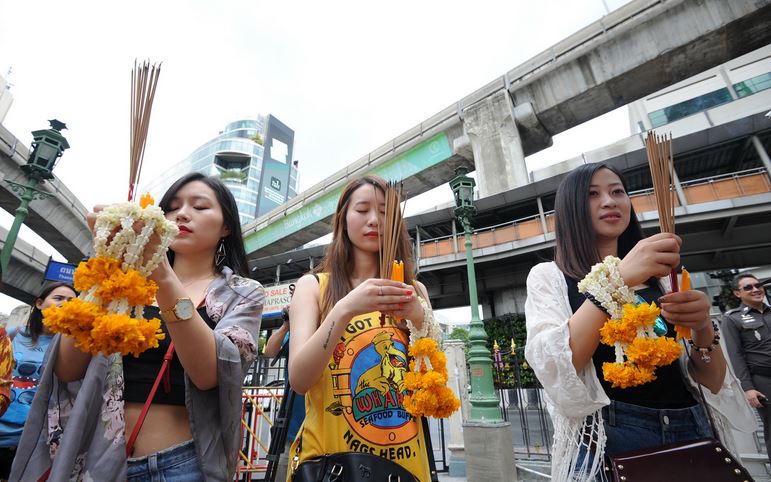
Loud, obnoxious and with a lot of money to spend. The stereotype of the "ugly American tourist" is increasingly being replaced, at least anecdotally, by the "ugly Chinese tourist" as more and more travelers from an increasingly wealthy mainland China make their way outside of their own home country.
This is particularly true in Thailand, where the Tourism Authority of Thailand hopes to bring in 10.8 million Chinese tourists in 2017, with a projected spend of 5.74 billion baht, or about US$170 million.
What a difference 20 years makes.
When the landmark “Amazing Thailand” travel and tourism marketing campaign launched in 1998, the country was contending with the very real aftermath of the Asian financial crisis. Beginning 20 years ago in July 1997, following Thailand’s devaluation of its currency, the economic contagion spread across Southeast Asia to Indonesia, as well as to South Korea and elsewhere.
In September 2016, Bangkok was named the top-ranked destination city by international overnight visitor arrivals in the sixth annual MasterCard Global Destinations Cities Index. Asian cities including three from ASEAN, according to the MasterCard ranking, now make up half of the global Top 10 cities – Bangkok, Singapore, Kuala Lumpur, Tokyo and Seoul – and seven of the top 10 fastest growing destination cities – Osaka, Chengdu, Colombo, Tokyo, Taipei, Xi’an and Xiamen.
Today, as Thailand and much of Asia welcomes more and more visitors from China, the region’s leaders and policymakers must take steps toward a more sustainable tourism industry and accelerate supporting infrastructure. Ensuring tourism is a sustainable driver of economic growth will require much more than sustained support for even the best marketing campaigns.
Tourists, whether from China, the United States or elsewhere, must also do their part and become "noble travelers" by better understanding the positive and negative economic and environmental impact of their travel dollars, adjusting spending accordingly. With viral videos of misbehaving Chinese tourists now supplementing those focused on travelers from the United States and elsewhere, more education and engagement will also be key to ensuring a warm welcome for visitors of all nationalities.
All this was underscored to me with the news this year that 40 tons of garbage had been collected in a single day in "Bali's Biggest Beach Cleanup." Some 12,000 volunteers drawn from local and international communities and businesses took part in helping clean up some 55 sites along the coastline of this "Island of the Gods."
And therein lies a critical challenge for tourism authorities in Southeast Asia and around the region marketing to Chinese and others. As tourism authorities seek to creatively brand destinations and capture visitors with catchy slogans (“Wonderful Indonesia” and “Malaysia, Truly Asia” are just two examples), is unchecked economic development threatening the long-term sustainability of the very attractions they promote to bring in travelers? How do you ensure that Cambodia is a “Kingdom of Wonder” or that indeed it remains true that "It's More Fun in the Philippines" when geopolitics and unrest intervene?
For many Southeast Asian nations, tourism is big business, and destinations — both entire countries and individual cities — are battling for their share of the lucrative traveler’s dollar. In Thailand — the “Land of Smiles” — in 2016, the travel and tourism sector contributed $36.7 billion to the Thai economy, equivalent to 9.2 percent of total gross domestic product (GDP), according to the World Travel and Tourism Council, a global body bringing together major players in the travel and tourism sector.
Indirectly, the sector’s contribution to Thailand's GDP was even larger, comprising an estimated $82.5 billion, or 20.6 percent of the national total in 2016. Thailand, according to the World Travel and Tourism Council, is projected to have the world’s 10th fastest growing tourism sector over the coming decade, averaging annual growth of 6.7%.
Understandably, governments across Southeast Asia and around the world are investing in travel and tourism, and in "country branding" campaigns. The promotions and publicity seem to be working, with large numbers of international visitors – including growing numbers of Mainland Chinese tourists – drawn to Bangkok and other Asian cities.
Selfie-stick and umbrella-wielding travelers from and to Asia are on the move. As measured by the MasterCard’s 2016 Global Destination Cities Index, travelers ranked Bangkok the No. 1 destination, followed by London, Paris, Singapore and New York.
But visitors should not ignore the region’s economic realities. According to the Asian Development Bank's Key Indicators for Asia and the Pacific, 2016:
Approximately 1.2 billion people in Asia and the Pacific are below the poverty line of $3.10 (2011 PPP) a day. About 1.5 billion lack access to proper sanitation. 330 million people still live on less than $1.90 a day. And, roughly 300 million people live without safe drinking water.
Disparities in income may well be less visible than trash on a beach, inadequate plumbing or smog-filled skies. But as poverty in the region has decreased, inequality has often widened.
Among Asia destinations for which data is available from the CIA World Factbook, the worldwide rankings (out of 149 places ranked) in order of most unequal to least unequal distribution of family income include: Micronesia (4th), Hong Kong (9th), Papua New Guinea (13th), Sri Lanka (20th), Thailand (24th), China (32nd), Malaysia (33rd), the Philippines (36th) and Singapore (39th). The United States is ranked the 43rd most unequal.
While individual cities may well in the short-term move up or down the MasterCard Index and other annual rankings, government and tourism officials in the long-term need to incorporate a healthy dose of accountability in their spending as they brand and market their own parts of Asia to the world.
Asia's governments must address inequality of opportunity, which can undercut the entrepreneurs and small and medium sized enterprises critical to any nation's tourism industry in the long run.
This should include openly and transparently bidding out development opportunities, putting in place clear land titling and investment rules and regulations, and increasing competition in aviation and hospitality.
Community-based tourism projects that give local residents a voice into what type of tourism projects are planned for their communities can also help build sustainability. Local players can have some of the best insights into how projects should be managed, and how to ensure a fair share of profits go back to the community.
Travel and tourism campaigns must be research-based and results-driven, and more than vanity projects for officials seeking industry dollars from hoteliers and industry members who are unable to say no.
In the end, a “re-think” is needed. The marketing of Asia’s diversity of destinations can both better reflect today’s realities and also be leveraged to tackle the region’s very real inequalities. Twenty years after the Asian Financial Crisis, a recovered Asia and Pacific region should now do more to ensure tourism’s growing economic benefits extend more broadly. Skeptical policy makers and business leaders may well be surprised to find the result is both sustained growth and more sustainable tourism, whether the visitors are from China, the United States or elsewhere.
